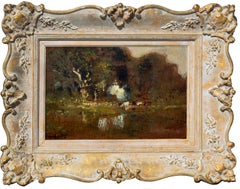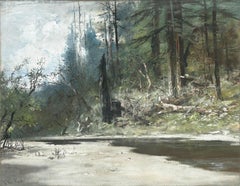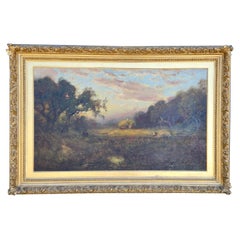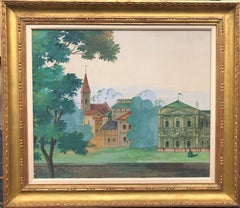William Keith Art
to
4
4
4
1
1
Cattle By Pond At Dusk, Mid-19th Century Tonalist Landscape by William Keith
By William Keith
Located in Soquel, CA
Cattle By Pond At Dusk, Mid-19th Century Tonalist Landscape by William Keith
Gorgeous mid-19th century landscape painting by William Keith (American, 1838-1911), circa 1860. This impressive Tonalist landscape, titled "In the Woods", depicts cattle beside a pond in the forest at dusk. Keith uses loose, blended brush strokes and a muted earthy palette to create an atmospheric mood that Tonalism is known for.
Signed "W. Keith" lower left.
Museum label on verso from Santa Barbara Museum of Art.
Presented in an antique giltwood frame.
Image size: 9"H x 13"W. With frame measures: 16"H x 20"W x 3"D.
Provenance:
Mrs. Eugene Patterson; Santa Barbara Museum of Art.
Authenticity guaranteed and certificate include.
Condition:
Very good. Cleaning and restoration required signature to be re-touched, original images pre-restoration available.
About the Artist:
Brought to New York City in 1850, William Keith was apprenticed to a wood engraver in 1856 working for "Harper's" magazine. In 1858 (or 1859) he visited California for "Harper's" and then after a trip to Great Britain, settled in California as an engraver in 1862. He began exhibiting paintings in 1864 in San Francisco where he opened his studio, after having been taught painting by his wife.
The Northern Pacific Railroad...
Category
1890s Pre-Raphaelite William Keith Art
Materials
Oil, Illustration Board
"Western Wilderness Interior" William Keith, California Tonalist, Forest Stream
By William Keith
Located in New York, NY
William Keith
Western Wilderness Interior
Signed lower left
Watercolor on paper laid on artist board
14 1/2 x 19 inches
A native of Scotland, William Keith became in the late 19th ...
Category
Late 19th Century Tonalist William Keith Art
Materials
Paper, Watercolor, Board
Large-Scale William Keith Landscape Painting "Harvest"
By William Keith
Located in Fulton, CA
Exceptional 19th century landscape painting by Important American artist William Keith. Titled "Harvest". Barbizon School oil on canvas painting featuring figures at harvest with cart and oxen. Amazing luminescent sky. Signed lower left corner "W. Keith '96". Retains original museum quality gilt frame. Canvas measure 30"H 50"W. Accompanied with period correct Stereograph black and white photograph depicting actual painting in a parlor with handwritten pencil title "Parlor, Berkeley, Cal. '97". This is a museum quality work of art.
William Keith (1838-1911)
William Keith became in the late 19th and early 20th centuries a leading Northern-California landscape artist. In fact, he was so well known that he is referred to as the "Dean of California painters" and "California's Old Master."
Born in Aberdeenshire, Scotland, Keith came to New York with his family and, apprenticed to a wood engraver. In 1859, he moved to San Francisco where he worked for an engraver and later set up his own engraving business. Studying with Samuel Marsden Brookes in 1863, he determined to become a painter.
He married artist Elizabeth Emerson and did watercolor painting with her guidance. In 1868, he became a full-time painter, and that same year was commissioned to paint scenes along the Columbia River including Mount Hood. By August 1869 he had sold enough paintings to finance an extended journey to the East Coast and Europe including Dusseldorf, Germany throughout most of 1870, studying with Albert Flamm. After a visit to Paris, he expressed great admiration for "the modern school of French landscape painting including the Barbizon School.
During the winter of 1871-1872, the Keiths lived in Boston where they shared a studio with William Hahn. Keith's work received critical acclaim there and in New York at the National Academy of Design. In 1872, he returned to San Francisco. A friendship with naturalist John Muir exposed Keith to many remote places and in-depth knowledge of nature. During the 1870s, he painted several "epic" eight by ten-foot High Sierra views. He also visited Alaska, and his paintings of Alaska were exhibited upon his return to San Francisco in a show at the Bohemian Club, titled 'Dreams of Alaska'. Keith's Alaska works are significant because they are not close transcriptions of actual scenery, but rather are fantasies inspired by Alaska. They are important as they represent a major break from the documentary tradition in landscape painting of Alaska, as they show an interest in capturing its spirit versus just the topography.
In 1891, he shared his studio for several weeks with East Coast Tonalist George Inness, Sr. [1825-1894]. Both men painted in a similar style and were followers of the mystical teachings of Swedenborg. Among the locations where Inness and Keith painted together were Monterey and Yosemite, and it was reported they discussed art from every possible angle. Under Inness' influence, Keith painted more than ever in a Barbizon-influenced vein with many sunset and twilight scenes.
Keith’s first wife died in 1882, and in 1883, he married Mary McHenry, the first woman graduate of Hastings Law School. They soon went to Europe, and Keith studied portrait painting in Munich with consultations from J. Frank Currier...
Category
Late 19th Century American Barbizon School Antique William Keith Art
Materials
Gesso, Canvas, Wood, Paint
Mount Tamalpais, Marin County, California
By William Keith
Located in Milford, NH
An exceptional tonalist landscape of Mount Tamalpais in Marin County, California by Scottish American artist William Keith (1838-1911). Keith was born in Aberdeenshire, Scotland and came to New York with his family and apprenticed to a wood engraver. In 1859, he moved to San Francisco where he worked for an engraver and later set up his own engraving business. Studying with Samuel Marsden Brookes in 1863, he was determined to become a painter. He married artist Elizabeth Emerson and did watercolor painting with her guidance. In 1868, he became a full-time painter, and that same year was commissioned to paint scenes along the Columbia River including Mount Hood. By August 1869 he had sold enough paintings to finance an extended journey to the East Coast and Europe including Dusseldorf, Germany throughout most of 1870, studying with Albert Flamm...
Category
1880s Tonalist William Keith Art
Materials
Oil, Board
Related Items
French School Road Line III New York City oil Post Impressionist th century AUC
Located in Zofingen, AG
Road Line III
Landscape - Sky scrappers, office- NYC Building avenue Painting with mirror effect
Technique: oil, acrylic, and ink on old book pages on wooden frame 40x40cm ■■ 15,7x...
Category
Early 1900s Tonalist William Keith Art
Materials
Acrylic, Stretcher Bars, Mixed Media, Glue, Oil
$2,122
H 15.75 in W 15.75 in D 1.38 in
View Of The City
Located in Lake Worth Beach, FL
Early 20th Century European School, view of the city, with buildings in the background, gouache on paper unsigned in a beautiful custom made Haydenryk frame under glass.
Category
Early 20th Century Realist William Keith Art
Materials
Gouache, Board
Green Field and Barn - A Tonalist Landscape by Robertson Mygatt
Located in Philadelphia, PA
Robertson K. Mygatt
(American, 1862-1919)
Green Field and Barn
Oil on panel, 6 1/8 x 9 7/8 inches
Framed: 10 x 15 inches
The landscape painter and etcher Robertson K. Mygatt was born in New York City and studied at the Art Students’ League with John Twachtman...
Category
1910s Tonalist William Keith Art
Materials
Oil, Wood Panel
$4,000
H 6.125 in W 9.875 in
Sailing Among the Moonlight, Moody Seascape, Tonalism
Located in Grand Rapids, MI
European School, 19th Century
" Sailing Among the Moonlight ", circa 1880s
Oil on Board
16" x 24"
Housed in a Period 4" Ornamented Frame
Overall Size: 23 5/8" x 31 1/2"
A wond...
Category
Late 19th Century Tonalist William Keith Art
Materials
Oil, Board
$1,507 Sale Price
25% Off
H 23 in W 31.5 in
French School Road Line III New York City Impressionist Chut Les Barbizons!
Located in Zofingen, AG
☀️⭐Road Line III ⭐☀️
Landscape - Sky scrappers, office- NYC Building avenue Painting with mirror effect
Technique: oil, acrylic, and ink on old book pages on wooden strecher frame ...
Category
1920s Tonalist William Keith Art
Materials
Glue, Mixed Media, Oil, Acrylic
$465 Sale Price
75% Off
H 15.75 in W 15.75 in D 1.38 in
French school The River Oil painting Signed
Located in Zofingen, AG
➡️The River from Rousseau⬅️
"Il est tombé par terre, C'est la faute à Voltaire, Le nez dans le ruisseau, C'est la faute à Rousseau" - He fell to the ground, It's Voltaire's fault, H...
Category
1890s Tonalist William Keith Art
Materials
Gesso, Canvas, Oil, Stretcher Bars
$589 Sale Price
79% Off
H 12.41 in W 18.71 in D 1.19 in
Bathers 1940s Mid 20th Century American Scene Social Realism WPA Modern Ashcan
Located in New York, NY
Bathers 1940s Mid 20th Century American Scene Social Realism WPA Modern Ashcan
Marion Gilmore (1909-1984)
Bathers
15 1/2 x 19 1/2 inches
oil on canvas boar...
Category
1940s American Realist William Keith Art
Materials
Oil, Board
Antique Painting Rural Landscape William Langley 19th Century
By William Langley
Located in London, GB
This is a beautiful English antique oil on canvas painting "Near Llantwest, North Wales" by William Langley (English, 1852-1922), signed lower left and inscribed to verso.
The decor...
Category
19th Century English Antique William Keith Art
Materials
Canvas, Giltwood
Diana Nemorensis - 19th Century NeoClassical Oil Painting Ancient Roman Goddess
By Max Nonnenbruch
Located in Gerrards Cross, GB
‘Diana Nemorensis’ by Max Nonnenbruch (1857-1922). The painting – which depicts the Roman Goddess Diana of the Woods beside Lake Nemi – is signed by the artist and presented in a fin...
Category
Late 19th Century Pre-Raphaelite William Keith Art
Materials
Oil
$15,253 Sale Price
40% Off
H 42 in W 30 in D 3 in
Dennis Sheehan, "Mid Fall" 12x12 Tonalist Tree Landscape Oil Painting on Canvas
By Dennis Sheehan
Located in Saratoga Springs, NY
This piece, "Mid Fall", by artist Dennis Sheehan is a 12x12 oil painting on canvas featuring a daytime landscape setting during autumn. Tree leaves are deep reds, purple, oranges an...
Category
2010s Tonalist William Keith Art
Materials
Canvas, Oil
$1,880 Sale Price
20% Off
H 12 in W 12 in
French school Landscape river scene Signed
Located in Zofingen, AG
➡️ Beautiful study Landscape⬅️
Title: Sur les bords du Loing (Seine et Marne France) Jean Baptiste Camille Corot
Medium: Oil on canvas
Period: Likely mid-19th century
Framing: A wid...
Category
1850s Tonalist William Keith Art
Materials
Gesso, Canvas, Oil, Stretcher Bars
$129,715 Sale Price
26% Off
H 14.18 in W 21.46 in D 1.58 in
Late 19th Century Tonalist Landscape with Oak Trees
By Willard LeRoy Metcalf
Located in Soquel, CA
Gorgeous late 19th century Tonalist landscape painting of foothills and oak trees in the style of Willard Leroy Metcalf circa 1900. Inscribed "M" in circle monogram lower left corner and on frame verso. Presented in original rustic giltwood frame. Image size: 6"H x 8"W. Framed size: 8.5"H x 10.5"W.
Tonalist are usually intimate works, painted with a limited palette. Tonalist paintings are softly expressive, suggestive rather than detailed, often depicting the landscape at twilight or evening, when there is an absence of contrast. Tonalist paintings could also be figurative, but in them, the figure was usually out of doors or in an interior in a low-key setting with little detail.
Tonalism had its origins in the works of the French Barbizon school and in the works of American painters who were influenced by them. California Tonalism was born when the emphasis in California landscape painting passed from the grand landscapes of works like those of Thomas Hill and William Keith's early career, to more intimate views of a domesticated landscape. At the same time, the parallel Pictorialist Photography...
Category
1890s Tonalist William Keith Art
Materials
Oil, Cardboard
$6,800 Sale Price
20% Off
H 8.5 in W 10.5 in D 1 in
Previously Available Items
"Last Light, Landscape at Sunset, " William Keith, California Tonalist, Forest
By William Keith
Located in New York, NY
William Keith (1838 - 1911)
Last Light, Landscape at Sunset
Oil on canvas
25 x 30 inches
Signed lower right
A native of Scotland, William Keith became in the late 19th and early 20th centuries a leading Northern-California landscape artist. In fact, he was so well known that he is referred to as the "Dean of California painters." His romanticized views of nature found much favor among the culturally aspiring citizens of San Francisco and hung in many foyers and dining rooms in their elegant homes. He completed thousands of paintings and drawings, and many of them were lost in his studio in the fire of 1906.
His early works are dramatic mountainscapes in a realistic style adopted from the Dusseldorf School of Germany. The paintings of the last two decades of his life are looser and obviously influenced by his exposure in France to the Barbizon School of landscape painters, who were the first colony of painters to complete paintings "en plein air," or directly from nature rather than in studios. A forerunner of Impressionism, this style also included Tonalism espoused by Barbizon painter Camille Corot [1796-1875] and also apparent in Keith's later works, which are darker, smaller, and much more intimate with emphasis on mood.
Born in Aberdeenshire, Scotland, Keith came to New York with his family and, apprenticed to a wood engraver. In 1859, he moved to San Francisco where he worked for an engraver and later set up his own engraving business. Studying with Samuel Marsden Brookes in 1863, he determined to become a painter.
He married artist Elizabeth Emerson and did watercolor painting with her guidance. In 1868, he became a full-time painter, and that same year was commissioned to paint scenes along the Columbia River including Mount Hood. By August 1869 he had sold enough paintings to finance an extended journey to the East Coast and Europe including Dusseldorf, Germany throughout most of 1870, studying with Albert Flamm. After a visit to Paris, he expressed great admiration for "the modern school of French landscape painting including the Barbizon School.
During the winter of 1871-1872, the Keiths lived in Boston where they shared a studio with William Hahn. Keith's work received critical acclaim there and in New York at the National Academy of Design.
In 1872, he returned to San Francisco. A friendship with naturalist John Muir exposed Keith to many remote places and in-depth knowledge of nature. During the 1870s, he painted several "epic" eight by ten-foot High Sierra views. He also visited Alaska, and his paintings of Alaska were exhibited upon his return to San Francisco in a show at the Bohemian Club, titled 'Dreams of Alaska'. Keith's Alaska works are significant because they are not close transcriptions of actual scenery, but rather are fantasies inspired by Alaska. They are important as they represent a major break from the documentary tradition in landscape painting of Alaska, as they show an interest in capturing its spirit versus just the topography.
The first wife of William Keith died in 1882, and in 1883, he married Mary McHenry, the first woman graduate of Hastings Law School. They soon went to Europe, and Keith studied portrait painting in Munich with consultations from J. Frank Currier and Carl Marr for two years. Keith then settled for the remainder of his life in Berkeley, California, at 2207 Atherton Street. His studio was in San Francisco where he commuted daily, painted prolifically, and taught many classes, mostly for aspiring female artists .
In 1891, he shared his studio for several weeks with East Coast Tonalist George Inness, Sr. [1825-1894]. Both men painted in a similar style and were followers of the mystical teachings of Swedenborg. Among the locations where Inness and Keith painted together were Monterey and Yosemite, and it was reported they discussed art from every possible angle. Under Inness' influence, Keith painted more than ever in a Barbizon-influenced vein with many sunset and twilight scenes.
By the early 1900s, Keith was likely one of the wealthiest artists in the United States and certainly earned the most money of any California-based artist. People from all over the world sought out his studio where it was said that he would specially select a painting for a client from behind a black velvet curtain...
Category
Late 19th Century Tonalist William Keith Art
Materials
Canvas, Oil
William Keith art for sale on 1stDibs.
Find a wide variety of authentic William Keith art available for sale on 1stDibs. You can also browse by medium to find art by William Keith in oil paint, paint, board and more. Much of the original work by this artist or collective was created during the 19th century and is mostly associated with the Impressionist style. Not every interior allows for large William Keith art, so small editions measuring 22 inches across are available. Customers who are interested in this artist might also find the work of Edward Henry Potthast, Henry Bacon, and Irving Ramsey Wiles. William Keith art prices can differ depending upon medium, time period and other attributes. On 1stDibs, the price for these items starts at $3,080 and tops out at $27,500, while the average work can sell for $16,000.



